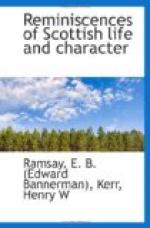In our reminiscences of many changes which have taken place during fifty years in Scottish manners, it might form an interesting section to record some peculiarities which remain. I mean such peculiarities as yet linger amongst us, and still mark a difference in some of our social habits from those of England. Some Scottish usages die hard, and are found still to supply amusement for southern visitors. To give a few examples, persons still persist among us in calling the head of a family, or the host, the landlord, although he never charged his guests a halfpenny for the hospitality he exercises. In games, golf and curling still continue to mark the national character—cricket was long an exotic amongst us. In many of our educational institutions, however, it seems now fairly to have taken root. We continue to call our reception rooms “public rooms,” although never used for any but domestic purposes. Military rank is attached to ladies, as we speak of Mrs. Lieutenant Fraser, Mrs. Captain Scott, Mrs. Major Smith, Mrs. Colonel Campbell. On the occasion of a death, we persist in sending circular notices to all the relatives, whether they know of it or not—a custom which, together with men wearing weepers at funeral solemnities, is unknown in England[189]. Announcing a married lady’s death under her maiden name must seem strange to English ears—as, for example, we read of the demise of Mrs. Jane Dickson, spouse of Thomas Morison. Scottish cookery retains its ground, and hotch-potch, minced collops, sheep’s head singed, and occasionally haggis, are still marked peculiarities of the Scottish table. These social differences linger amongst us. But stronger points are worn away; eccentricities and oddities such as existed once will not do now. One does not see why eccentricity should be more developed in one age than in another, but we cannot avoid the conclusion that the day for real oddities is no more. Professors of colleges are those in whom one least expects oddity—grave and learned characters; and yet such have been in former times. We can scarcely now imagine such professors as we read of in a past generation.




